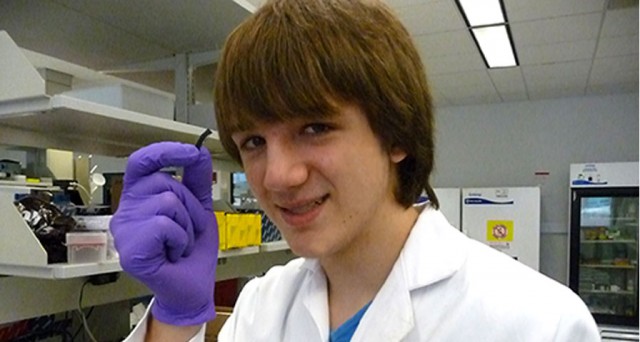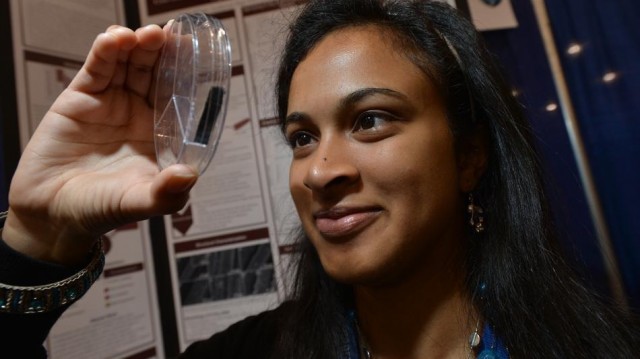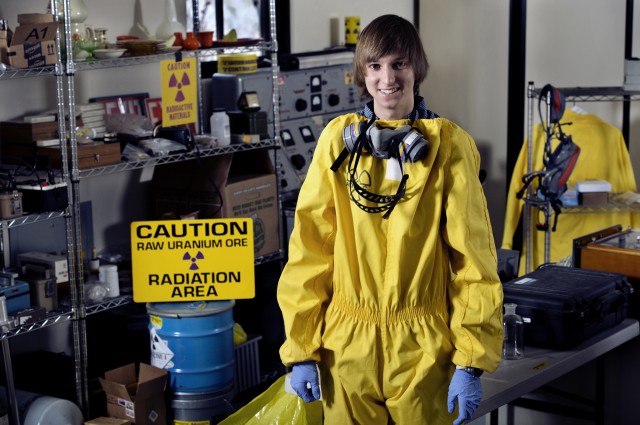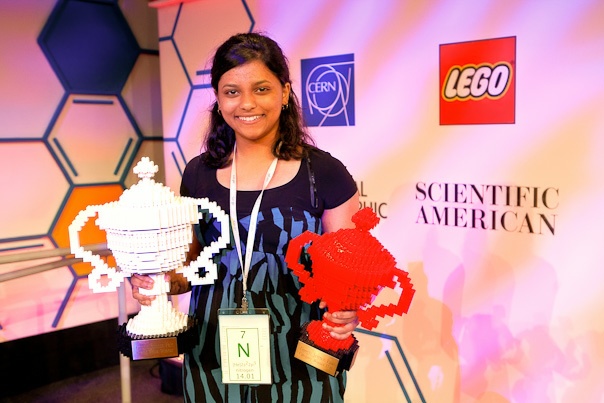More and more teenagers are making scientific breakthroughs. From cancer diagnostics and treatments to renewable energy and advancements in biodegradability, these teen researchers will make you ashamed of your science fair baking soda volcano.
10. Jack Andraka
Jack Andraka created a biosensor for pancreatic cancer that he alleges is 168 times faster, 26,667 times less expensive and 400 times more sensitive than current diagnostic technology. He used carbon nanotubes, bound them to antibodies for the cancer biomarker mesothelin. and put all of this onto a strip of filter paper. This gave him a sensor that could detect pancreatic, ovarian and lung cancer. He was only 15.
His research made waves because of the abysmally low survival rate of pancreatic cancer and the innovative method he used. He secured a patent lawyer after winning the Grand Prize at the 2012 Intel International Science & Engineering Fair (ISEF), and started his own company, Andraka LLC, in December 2012. He’s the youngest person to have spoken in front of the Royal Society of Medicine, and he’s met the President.
9. Sara Volz
Sara Volz performed experiments in which she selectively bred algae based on their oil output for the purpose of making them more commercially viable as biofuel. This research is especially relevant as the world continues to search for a way to lessen our dependence on fossil fuels. She won the top prize of $100,000 in the Intel Science Talent Search. Her dedication to the project is clear from the fact that, as she needed to check on the algae regularly, she kept them in a makeshift lab under her bed and slept on their light cycle.
8. Elana Simon
Elana Simon was diagnosed with fibrolamellar hepatocellular carcinoma, a rare form of liver cancer, when she was twelve years old. Instead of letting it get her down, at the age of fifteen she worked with her surgeon and a friend to appeal for tumor samples from other patients, and performed a study on the genetics of this cancer.
Elana, her father and her surgeon worked in Rockefeller University and with the New York Genome Centre. They sequenced the genomes of the tumor samples, compared them to normal cells and other kinds of cancer, and found a mutation in the fibrolamellar samples. The end of one gene joined the back of the next, creating a protein called a chimera. Further research needs to be done, but Elana co-authored a paper in the prestigious journal Science on her work. She spoke to President Obama about her research at the 2014 White House Science Fair, received the Junior Champion Cancer Research Award from the American Association of Cancer Research and plans to study computer science at Harvard.
7. Daniel Burd
Daniel Burd is working on a solution to the problem of the slow decomposition of plastic bags. Plastic normally takes a long time to decompose (estimates vary, but go up to thousands of years), but this high school junior managed to do it in three months.
He reasoned that plastic does eventually degrade, so there must be a reason. That reason, he guessed, was bacteria. In a preliminary experiment, he buried plastic bags with dirt and yeast, and found that they did decompose faster. He then performed tests to isolate the bacteria responsible and found that these two strains were most effective for decomposing the polyethylene. 43% of the plastic had degraded within six weeks, an incredible record.
He thinks the rest would be gone in three months. His solution doesn’t pollute either; it only leaks water and trace amounts of carbon dioxide. He claims it’s industrially scalable and could easily be applied elsewhere.
6. Eesha Khare
Eesha Khare built a super-capacitor that can charge an LED in twenty seconds. Her small device can last through 10,000 charge cycles, as opposed to the standard 1,000. It’s built using nano-structures, making it more environmentally friendly than normal batteries and allowing her devices to hold more energy per unit volume. The device can also fold and bend easily.
There has been much talk of using this technology in phone and car batteries, but this could still be quite far off because of the big difference in energy usage between phones and LEDs. However, charging an LED that fast remains a terrific advancement. She’s the 2013 runner-up in the Intel ISEF and won a $50,000 prize, while publications from Business Insider to Time have echoed the girl’s enthusiasm for the device’s practical applications.
5. Marc Roberge
Marc Roberge discovered a way to neutralize anthrax in an envelope, and it’s deceptively simple — ironing. He destroyed the bacteria by ironing the envelope for five minutes at a high temperature. Obviously, he couldn’t use real anthrax, but he got a substitute commonly used by scientists, bacillus subtilis. This substitute also happens to be more resistant to heat than anthrax, which adds strength to his findings. He says he got the idea from a conversation with his father, a medical toxicologist for the Center for Disease Control and Prevention.
His research was published in the Journal of Medical Toxicology in June 2006. Incidentally, ironing letters doesn’t blur ink or make them open up too early. The paper’s unashamedly punny title is ‘Bacillus spores in the mail: “Ironing” out the anthrax problem.’
4. Taylor Wilson
Taylor Wilson was the youngest person on Earth to achieve nuclear fusion. His goal didn’t come out of nowhere; at eleven years old he was inspired by Shel Silverstein’s book The Radioactive Boy Scout, a novel in which a kid tries and fails to build a nuclear reactor.
Taylor thought he could do better. This, coupled with his passion for the radioactive elements of the Periodic Table, led him to conduct a “survey of everyday radioactive materials” for his school science fair. He procured a Geiger counter from a friend and went around on weekends looking for radioactivity. But this was small-scale stuff compared to what happened next.
Long story short, he wanted to build a small nuclear reactor. His family moved across the country and he enrolled in a school for profoundly gifted students. To make a working nuclear reactor, he’d need to focus 100,000 volts of energy to fuse atoms together, in a vacuum stronger than space. And he did it at the age of fourteen. He took his project to Intel ISEF and joined Eesha Khare on this list as a runner-up, this time in 2011. He also received a Thiel Fellowship, which gave him $100,000 to skip college and work on his own research.
3. Easton LaChappelle
Easton LaChappelle built a functional prosthetic arm and hand that’s much cheaper than current models, thanks to his use of inexpensive 3D printing and open source technology. He had been working on a Lego arm for some time when he met a seven-year-old girl whose prosthetic arm had cost a staggering $80,000 and decided to work on the problem. His creation works better than a standard prosthesis, is stronger than a normal human arm and should retail for only $400.
LaChappelle’s worked in a NASA Robonaut team investigating how astronauts can control space robots from earth. He;s also won prizes at Intel ISEF but prefers to work away on his own. He hopes his device will be light enough and function well enough for everyday use by those in need of prosthetics.
2. Brittany Wenger
Brittany Wenger developed a computer program for better diagnosis of breast cancer — her program detected 99% of malignant breast tumors. She had experimented with artificial intelligence and neural networks in the seventh grade after teaching herself to code, and when her cousin was diagnosed with breast cancer she put it into practice. She wanted to encourage the use of a less invasive diagnostic technique, namely fine needle aspirates. Doctors generally don’t use them because they’re so often inconclusive, and she set out to change that.
Her program identifies visual patterns associated with breast cancer and screens based on that. It also learns from its mistakes and continuously gets more accurate. She’s also developed a program to diagnose leukemia. Her breast cancer program is being tested in two American hospitals, she won the Google Science Fair with the project, and yes, she met the President. She was also listed in Time’s 30 Under 30.
1. Shree Bose
Shree studied the chemotherapy drug cisplatin, which works by damaging DNA until repair is impossible and the cells make themselves explode (sometimes science can be pretty hardcore). Unfortunately, cancer cells often develop a resistance to cisplatin, making the treatment useless. She investigated a protein called AMPK and its effects on cell resistance to cisplatin, and her research could help fight ovarian cancer by combating drug resistance and maintaining cisplatin’s effectiveness as a chemotherapy drug. Shree says that the enzyme might be playing a role in making cancer cells resistant. She won the overall prize in the 2011 Google Science Fair.










1 Comment
Maybe there is hope for us yet…